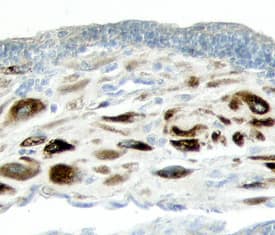Human ADAMTS1 Propeptide Antibody
R&D Systems, part of Bio-Techne | Catalog # AF3079

Key Product Details
Species Reactivity
Validated:
Cited:
Applications
Validated:
Cited:
Label
Antibody Source
Product Specifications
Immunogen
Leu50-Arg252
Accession # Q9UHI8
Specificity
Clonality
Host
Isotype
Scientific Data Images for Human ADAMTS1 Propeptide Antibody
ADAMTS1 in Human Placenta.
ADAMTS1 was detected in immersion fixed paraffin-embedded sections of human placenta using 15 µg/mL Goat Anti-Human ADAMTS1 Propeptide Antigen Affinity-purified Polyclonal Antibody (Catalog # AF3079) overnight at 4 °C. Tissue was stained with the Anti-Goat HRP-DAB Cell & Tissue Staining Kit (brown; Catalog # CTS008) and counterstained with hematoxylin (blue). View our protocol for Chromogenic IHC Staining of Paraffin-embedded Tissue Sections.Applications for Human ADAMTS1 Propeptide Antibody
Immunohistochemistry
Sample: Immersion fixed paraffin-embedded sections of human placenta
Immunoprecipitation
Sample: Conditioned cell culture medium spiked with Recombinant Human ADAMTS1 (Catalog # 2197‑AD), see our available Western blot detection antibodies
Western Blot
Sample: Recombinant Human ADAMTS1 (Catalog # 2197-AD)
Formulation, Preparation, and Storage
Purification
Reconstitution
Formulation
Shipping
Stability & Storage
- 12 months from date of receipt, -20 to -70 °C as supplied.
- 1 month, 2 to 8 °C under sterile conditions after reconstitution.
- 6 months, -20 to -70 °C under sterile conditions after reconstitution.
Background: ADAMTS1
ADAMTS1 (a disintegrin and metalloproteinase with thrombospondin motifs 1), also known as METH1, is the founding member of the family of secreted zinc proteases with a multi-domain structure (1-3). The protein precursors consist of signal peptide and following domains: pro, catalytic, disintegrin-like, TS type 1 motif, cysteine-rich, spacer and a variable number of TS type 1 motifs. Based on their substrate specificity, ADAMTS1 and associated family members may be key enzymes in degradation of cartilage leading to inflammation and arthritis (4). It is an active protease cleaving alpha-2-macroglobulin (5), aggrecan (6), and versican (7). Compared to ADAMTS4 (aggrecanase 1) and ADAMTS5 (aggrecanase 2), the aggrecanase activity of ADAMTS1 is lower. However, its activity can be enhanced by the binding of cofactor such as fibulin-1 (8). The aggrecanase activity can be inhibited using 5 mM 1,10 Phenanthroline. ADAMTS1 is essential for normal growth and the structure and function of the kidneys, adrenal glands and female reproductive organs (9). It also plays an important role in atherosclerosis (10). It has been shown to inhibit endothelial cell proliferation by direct binding and sequestration of VEGF165 and to inhibit fibroblast migration at high concentrations by binding to FGF-2 (11, 12). The purified rhADAMTS1 starts at the N-terminus of the catalytic domain and ends in the beginning of the spacer region.
References
- Vazquez, F. et al. (1999) J. Biol. Chem. 274:23349.
- Kuno, K. et al. (1997) J. Biol. Chem. 272:556.
- Porter, S. et al. (2005) Biochem. J. 386:15.
- Nagase, H. and M. Kashiwagi (2003) Arthritis Res. Ther. 5:94.
- Kuno, K. et al. (1999) J. Biol. Chem. 274:18821.
- Kuno, K. et al. (2000) FEBS Lett. 478:241.
- Russel, D. L. et al. (2003) J. Biol. Chem. 278:42330.
- Lee, N., et al. (2005) J. Biol. Chem. 280:34796.
- Shindo, T., et al. (2000) J. Clin. Invest. 105:1345.
- Wight, T.N. (2005) Arterioscler Thromb. Vasc. Biol. 25:12.
- Luque, A. et al. (2003) J. Biol. Chem. 278:23656.
- Krampert, M. et al. (2005) J. Biol. Chem. 280:23844.
Long Name
Alternate Names
Entrez Gene IDs
Gene Symbol
UniProt
Additional ADAMTS1 Products
Product Documents for Human ADAMTS1 Propeptide Antibody
Product Specific Notices for Human ADAMTS1 Propeptide Antibody
For research use only
